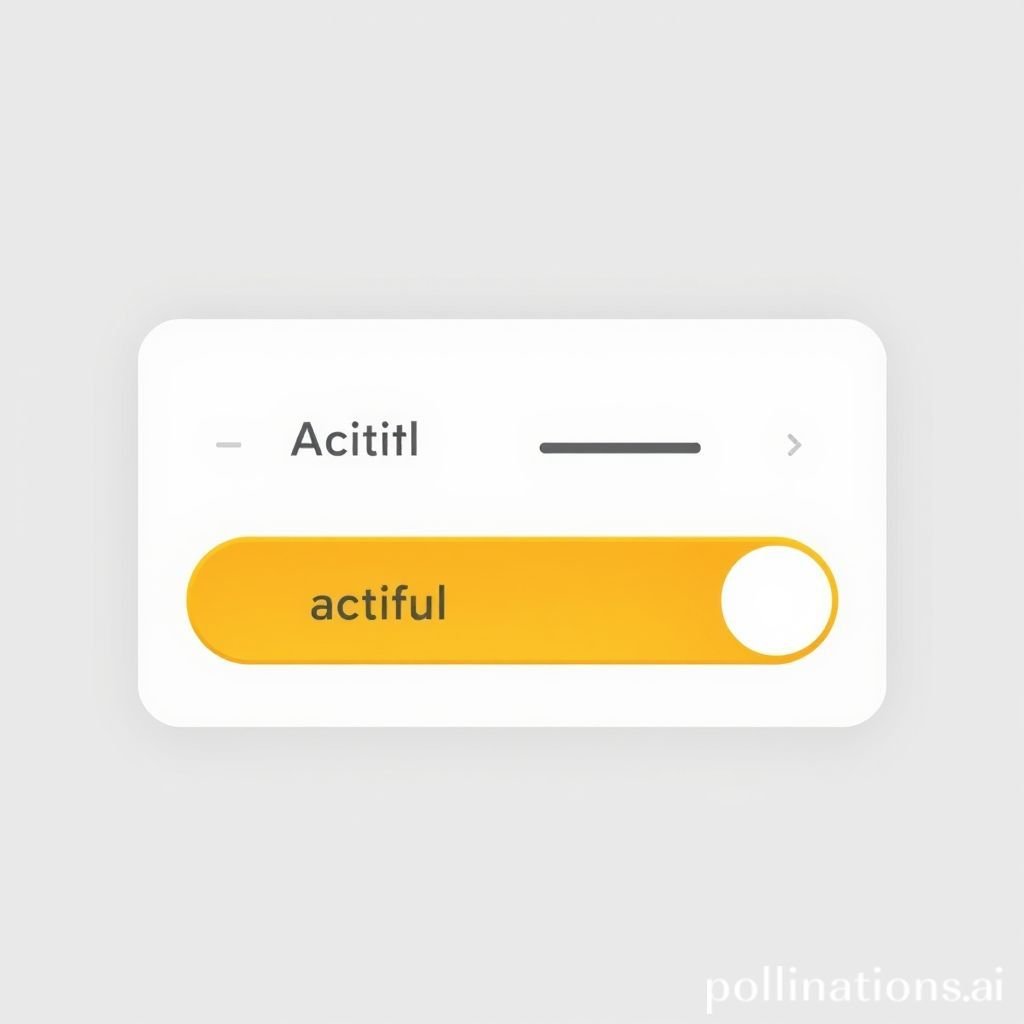UI Toggle Activate: Enhancing User Experience
The subtle yet powerful "UI Toggle Activate" sound effect plays a crucial role in enhancing user interface (UI) experiences across various digital platforms. This specific audio cue, often a crisp click or a gentle thunk, serves as an immediate auditory confirmation when a user interacts with a toggle switch, button, or any interactive element that changes state. Its practical applications span a vast range of digital products, from mobile apps and web interfaces to gaming consoles and industrial control systems. A well-designed UI sound like this provides instant feedback, reduces cognitive load, and builds a more intuitive and satisfying interaction, proving that even the smallest audio detail contributes significantly to overall UI quality.
Applications in Media
The "UI Toggle Activate" sound effect is a ubiquitous element in modern media, silently guiding users through complex interfaces and providing essential feedback. Its precise application varies widely, reflecting the diverse nature of digital content and interactive experiences.
Industry-Specific Uses
In the gaming industry, the "UI Toggle Activate" sound is indispensable. Whether a player is switching weapon modes, activating a shield, or turning on an in-game flashlight, a distinct audio cue confirms the action, preventing confusion and enhancing immersion. For example, a crisp "click" confirms the activation of a UI element, making the user's action feel responsive and tangible. Similarly, in mobile applications, this UI sound provides vital feedback for actions like turning on Wi-Fi, activating a silent mode, or enabling a feature within settings. Without it, users might repeatedly tap, unsure if their input was registered. For web applications, especially those involving dashboards or configuration panels, a well-placed "toggle activate" UI sound can improve perceived responsiveness and professionalism, making complex interactions feel smoother. In industrial control systems or specialized software, these UI sounds offer critical confirmation for operators, ensuring that actions like activating a specific function or changing a system setting are audibly acknowledged, which can be vital for safety and efficiency. This audio effect helps users understand the state change of a UI element.
Creative Techniques
Beyond mere functionality, creative application of the "UI Toggle Activate" sound effect can significantly enrich user experience. Designers often vary the timbre and pitch of the sound to convey different levels of importance or success. A low-pitched, subtle thunk might confirm a minor setting change, while a brighter, more assertive blip could signify the activation of a critical feature. Layering this UI sound with a slight reverb can give the impression of depth or a larger environment, particularly effective in virtual reality (VR) or augmented reality (AR) UI. Furthermore, integrating haptic feedback—a slight vibration—alongside the audio click can create a multi-sensory confirmation, making the interaction feel even more robust and satisfying. The goal is to make the user's interaction with the UI feel intuitive and natural, like pressing a physical button. For related UI sounds and inspiration, explore Related UI sounds.
Technical Analysis
Understanding the technical characteristics of a "UI Toggle Activate" sound effect is crucial for both its effective design and implementation. This section delves into the intrinsic properties that make these sounds so effective in their role as a confirmation cue.
Waveform Characteristics
The waveform of a typical "UI Toggle Activate" sound is often characterized by a sharp attack, a rapid decay, and a very short duration—usually ranging from 50 to 200 milliseconds. The initial peak, or "transient," is critical as it marks the precise moment of activation, providing immediate feedback to the user. This transient is often followed by a quickly diminishing tail, which gives the sound a sense of finality without lingering and becoming distracting. Visually, a "UI Toggle Activate" sound waveform visualization would show a sudden spike followed by a quick fade, reflecting its transient nature. The crispness of this attack is what defines the "click" or "pop" quality that is so effective for an activation sound. The sound's energy is concentrated at the very beginning of its duration, ensuring maximum impact.
Frequency Profile
The frequency profile of a good "UI Toggle Activate" sound typically resides in the mid to high-frequency ranges. Frequencies between 1 kHz and 8 kHz are commonly used, as these ranges are easily discernible to the human ear and cut through background noise without being harsh or fatiguing. A well-designed "toggle activate" UI sound might have a subtle sweep from a lower mid-frequency to a higher one, creating a perception of upward motion or completion. Lower frequencies can be added sparingly to give the sound more body or "weight," but too much low-end can make the sound muddy or less distinct. The emphasis on higher frequencies ensures that the sound is perceived as precise and immediate, perfectly suited for an instantaneous confirmation. This careful frequency shaping ensures the UI sound delivers clear and concise feedback.
Production Tips
Creating an effective "UI Toggle Activate" sound effect requires a blend of recording prowess, meticulous editing, and the right software tools. The goal is to produce a sound that is clean, impactful, and perfectly suited for its UI purpose.
Recording/Editing
When recording source material for a "UI Toggle Activate" sound, think about real-world sounds that convey a sense of decisive action or connection. Clicking a pen, tapping a light switch, or even flicking a small piece of plastic can yield excellent raw material. The key is to capture a clean recording with minimal background noise. Use a high-quality condenser microphone positioned close to the source. During the editing phase, the focus should be on isolating the crucial transient. Aggressively trim silence from before and after the desired sound. Apply gentle noise reduction if necessary, but avoid over-processing, which can lead to an unnatural or "phasey" sound. Subtle EQ adjustments can refine the frequency profile, boosting frequencies that contribute to the "click" and cutting those that introduce muddiness. Shorten the decay to ensure the sound doesn't linger. Consider subtle compression to make the attack more consistent and prominent, giving a robust confirmation.
Software Tools
Digital Audio Workstations (DAWs) like Ableton Live, Logic Pro X, FL Studio, or Pro Tools are indispensable for producing "UI Toggle Activate" sounds. These platforms offer precise editing capabilities, a wide range of effects, and robust mixing environments. For specialized sound design, tools like Native Instruments' Kontakt, with its powerful sampling and manipulation features, can be used to layer and sculpt complex UI sounds. Synthesis plugins like Serum or Vital can also generate unique "click" or "blip" sounds from scratch, offering complete control over the waveform and frequency profile. Essential plugins include EQs (parametric and graphic), compressors, and subtle reverbs for spatialization. Automation features within the DAW allow for dynamic changes in volume or filter sweeps, adding character to the activation sound. Professional sound effect libraries, such as those found on Pro Sound Effects, also offer excellent pre-designed "toggle activate" UI sounds that can be tweaked to fit specific project needs.
Creative Implementation
Beyond its basic function, the "UI Toggle Activate" sound effect can be creatively implemented to add depth, character, and an enhanced sense of user feedback to a UI. Thinking outside the box can transform a simple click into an integral part of the user journey.
Layering Methods
Layering is a powerful technique for creating rich and nuanced "UI Toggle Activate" sounds. Instead of relying on a single sound, combine multiple elements to achieve a unique sonic signature. For instance, a crisp "click" can be layered with a very short, subtle tonal element—perhaps a sine wave at a specific pitch—to give the activation a musicality that aligns with the overall aesthetic of the UI. Another approach is to layer a dry, immediate click with a very short, quiet burst of white noise to add a tactile, almost "fuzzy" quality, mimicking the sound of a real-world switch. Experiment with slightly different start times for each layer to create a subtle "pop" or "snap." The key is to ensure that the layered sounds complement each other and that no single element overwhelms the primary confirmation function of the UI sound. This method allows for unique and branded UI audio.
Spatial Effects
Spatial effects, even in subtle applications, can significantly enhance the perceived quality and realism of a "UI Toggle Activate" sound. While most UI interactions are two-dimensional, adding a touch of spatial processing can give the impression that the sound is emanating from a specific point or interacting with a virtual environment. A very short, small room reverb can make the sound feel like it exists within a physical space, rather than just being a flat sound. For interfaces that simulate 3D environments, such as gaming UIs or VR applications, more advanced spatializers can be used to position the "toggle activate" sound in relation to the UI element it accompanies. This creates a more immersive experience, where the UI element feels like a physical object within the virtual world. Even subtle stereo panning can add a sense of movement or distinction, making one activation sound slightly different from another. These effects contribute to a cohesive and intuitive UI.
Sound Pack Integration
Integrating the "UI Toggle Activate" sound effect into a larger sound pack or collection is essential for maintaining consistency and efficiency in a project's audio design. This ensures a unified audio experience across the entire user interface.
Using with Other Sounds
When incorporating the "UI Toggle Activate" UI sound, consider its relationship with other sounds within the same pack. For example, a successful activation sound should ideally contrast subtly with a "UI Toggle Deactivate" sound, perhaps by having a slightly higher pitch or a different attack characteristic. Similarly, ensure it complements other core UI sounds like button clicks, hover sounds, or notification chimes. The overall volume, frequency balance, and dynamic range of the "toggle activate" sound should be consistent with the rest of the pack to prevent jarring shifts in the user's auditory experience. A well-integrated UI sound system ensures that every click, every toggle, and every confirmation feels like part of a cohesive whole. This thoughtful approach ensures user interactions are smooth and consistent.
Complete Collection
For comprehensive audio solutions, obtaining a complete sound pack that includes the "UI Toggle Activate" sound alongside a full suite of UI elements is highly recommended. These packs often contain variations of the "toggle activate" sound, suitable for different contexts (e.g., light, heavy, metallic, digital), along with confirmation tones, error sounds, transition effects, and ambient UI elements. Utilizing a curated collection ensures consistency in sonic aesthetic and quality, saving significant production time. It provides a robust foundation for any project's auditory feedback system, making the development of intuitive and engaging UI elements much more streamlined. Get the full sound pack for comprehensive audio solutions.
FAQ: UI Toggle Activate Sound Effects
-
What is a "UI Toggle Activate" sound effect? It's an auditory cue, often a crisp click or subtle tone, that provides immediate confirmation when a user interacts with a toggle switch or UI element, indicating a successful activate action.
-
Why are "UI Toggle Activate" sounds important for user experience? They provide instant feedback, reduce uncertainty, and enhance the perceived responsiveness and intuitiveness of a UI. It's a crucial part of creating a satisfying click experience.
-
How do I choose the right "toggle activate" sound for my UI? Consider your product's brand identity and target audience. A good UI sound should be clear, unobtrusive, and consistent with other audio elements, providing a distinct confirmation.
-
Can I use the same "toggle activate" sound for different UI elements? While possible, it's often better to vary UI sounds subtly based on importance or context. A primary toggle activate might have a stronger click or higher pitch than a secondary one.
-
Where can I find high-quality "UI Toggle Activate" sound effects? You can find excellent options in professional sound effect libraries, often categorized under "user interface" or "UX sounds," providing diverse choices for your UI needs.




